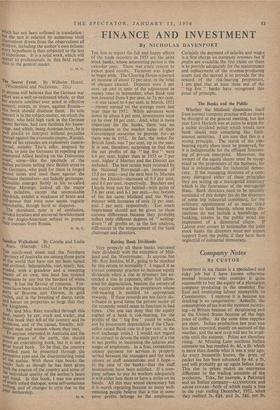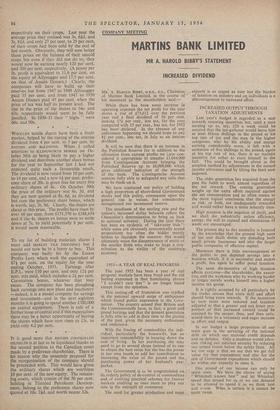Company Notes
respectively on their crops. Last year the average price they realised was 3s. 61d. and 3s. 81d. and only 27 per cent. to 29 per cent. of their crops had been sold by' the end of last month. Obviously, they will now better those prices on the balance of their unsold crops but even if they did not do so, they ' would now be earning nearly 120 per cent. and 300 per cent. respectively. (A penny per lb. profit is equivalent to 11.6 per cent. on the equity of Allynugger and 17.5 per cent. on that of Assam Dooars.) Clearly, the companies will have to build up their reserves but from 1947 to 1949 Allynugger paid 35 per cent, and from 1947 to 1950 Assam Dooars paid '45 per cent. when the price of tea was half its present level. The rise in the price of the shares to 34s. and 63s. respectively would seem to be fully justified. In 1950-51 their " highs " were 60s. and 90s.
* *
WOOLLEN textile shares have been a lively market, helped by the raising of the interim dividend from 4 per cent. to 5 per cent. by PATONS AND BALDWINS. When 1 called attention to ILLINGVvORTH MORRIS On Oc- tober 30th as being likely to pay a higher dividend and distribute another share bonus for the year to September last I had not expected quite such a favourable result. The dividend is now raised from 10 per cent. to 14 per cent. and a new 6* per cent. prefer- ence share of 20s. is given free for every five ordinary shares of 4s. On October 30th the price of the ordinary was 6s. 3d. and they are now quoted at 8s. 6d. ex dividend but cum the preference share bonus, which is worth, say, 3s. 9d. Clearly, the shares are cheap at this price. The profits have risen by Over 60 per cent. from £151,570 to £248,654 and if the 4s. shares ex bonus were to settle down at 7s. to yield potentially 8 per cent. it would seem reasonable.
*
To my list of building materials shares I must add MARLEY TILE (HOLDING) but I would not now be in a hurry to buy. This company was badly hit by the Excess Profits Levy which took the equivalent of 671 per cent, on the equity for the year ending October, 1953. Earnings after E.P.L. were 110 per cent. and only 121 per cent. was paid, which includes a 21 per cent. Coronation bonus, whatever that may mean. The company has been ploughing back earnings into new plant and machinery —indeed, it is a model compdny for savings and investment—and in the next eighteen months it is going to spend another £700,000 on capital equipment. There is talk of a further issue of capital and if this materialises there may be a better opportunity of buying the shares which have now risen to 15s. to yield only 4.2 per cent.



































 Previous page
Previous page